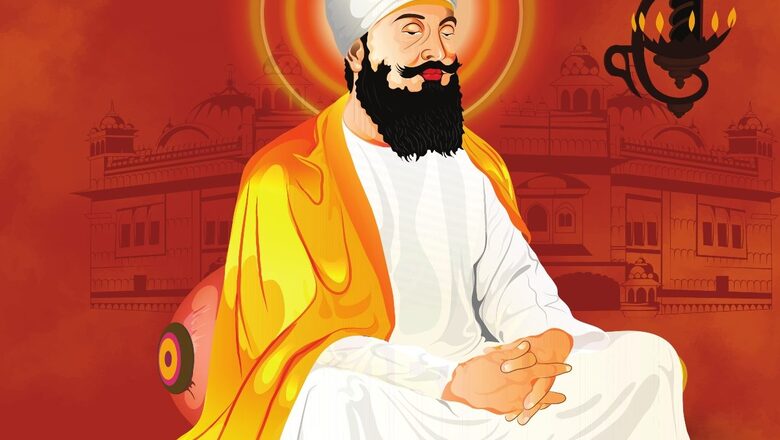
views
This year, on the martyrdom day of Guru Tegh Bahadur, it is important to reflect on how a powerful clique in the current generation of Sikhs has distorted the teachings of Sikh gurus to misappropriate and transmogrify Sikhism into an Abrahamic cult religion. Guru Nanak Dev founded Sikhism as a spiritual warrior faith to protect the indigenous Bharatiya culture and diversity of the Indian subcontinent, tracing back to its origins. Given the resurgent clash between intolerant monotheism and pluralistic pagan universalism, it is crucial to remember why Guru Nanak conceptualised Sikhism.
Its raison d’être was to uphold the umbilically linked Indian value systems from the existential threats of Islamic conquest. By cloaking such inconvenient history with the fog of secular policies today, neo-Sikhs do grievous injustice to their identity’s wellspring.
Guru Tegh Bahadur, the ninth guru of Sikhism, made the ultimate sacrifice to protect the religious freedom of Hindus facing violent oppression under the gory Mughal invader Aurangzeb. While earlier Mughal despots had been relatively tolerant of non-Muslim faiths, Aurangzeb was a religious fanatic bigot who aimed to impose Sharia law and forcible conversions across his empire. After the Hindu leadership implored his intercession, Guru Tegh Bahadur raised his voice for their religious freedom, challenged Aurangzeb and moved to Delhi to dissuade him from forcing Islamic conversions under the pain of death.
Guru Tegh Bahadur stood firmly by his convictions and refused to comply with Aurangzeb’s orders to convert to Islam. As was imminent, Aurangzeb tortured and executed his disciples in gruesome ways but failed to frighten the Guru, who upheld the right to freedom of religion. Ultimately, Aurangzeb beheaded Guru Tegh Bahadur publicly in Chandni Chowk on November 24, 1675, under a Banyan tree. By showcasing such singular valour bound to immutable principles, he ignited the subsequent rise of the valorous Khalsa as Hinduism’s resurgent defenders.
By giving his life for Hindus to safely practice their faith, Guru Tegh demonstrated that the role of a true Sikh is to selflessly serve and protect humanity against all forms of oppression and injustice. As a spiritual warrior and defender of religious tolerance, his martyrdom shone as a beacon of hope and resistance against bigotry, even under peril. This exemplary sacrifice by Guru Tegh Bahadur for upholding righteous values is the heritage that neo-Sikhs need to learn from to realign the community closer to its original vision.
Some members of the Sikh community distorting core Sikh beliefs for their own vested interests should recognise that their gurus created the faith as a shield and voice for Indian cultures being subdued by invaders. The holy scripture of Sikhs, Guru Granth Sahib, uses the word “Ram” 2533 times. The most frequently used word is “Hari”, which has been used a total of 8344 times. “Gobind” appears 475 times. There are 97 instances of the word “murari”. Interestingly, the epithet “Waheguru” finds only 13 mentions! The understanding to reflect the universally appealing spiritual humanism, which is the very essence of Sanatana Dharma, is at the heart of Sikhism.
On his Shaheedi Diwas, all Indians ought to honour his memory as a saint-soldier who martyred himself to protect and uphold dharma in the face of great injustice and religious persecution. His supreme sacrifice for the rights of the vulnerable and downtrodden is a shimmering demonstration of his unwavering courage and humaneness that inspires people today.
Shallow Depiction of Guru Tegh Bahadur’s Sacrifice
In despondent and dolorous attempts, the articles by Shiromani Gurdwara Parbandhak Committee (SGPC) and Delhi Sikh Gurdwara Management Committee (DSGMC) on Guru Tegh Bahadur’s life erase the core essence of why he sacrificed himself against Aurangzeb’s atrocities on Kashmiri Pandits. They have sanitised how the ninth guru defiantly stood up as a bulwark to safeguard Hindu Dharma, facing an existential crisis under Islamic persecution. Terms like “oppression”, “subjugation”, “persecution”, “genocide”, or “unimaginable horrors” are missing when referring to Aurangzeb’s state-sponsored campaign to ruthlessly convert or eliminate Kashmiri Hindus. The intent is to present the persecution faced by the Pandits in neutral terms, obscuring the communal genocide in a stark light.
The erasure of Guru Tegh Bahadur’s strategic decision to give up his life to awaken the spirit of resistance against Aurangzeb’s savage assault on Indic beliefs is striking. An SGPC article fails to highlight that the Guru made the well-thought-out choice of martyring himself publicly to ignite a long-term struggle against Islamic tyranny, threatening to wipe out India’s native diversity. His strategy was to inspire solidarity across different faiths against the Mughals by showcasing exceptional courage.
However, the SGPC depicts it vaguely as “self-sacrifice for the cause of ‘Righteousness’ and for the freedom of ‘Dharma’” without specifying that he stood up for the Hindus’ right to retain their own dharma. Similarly, the DSGMC refers ambiguously to his stand for ‘Righteousness’ and for the freedom of ‘Dharma’. This diluted articulation erases how the Guru paved the future path for the Sikh militancy actively defending Hinduism under existential threat.
Such write-ups fail to explicitly highlight how state repression under Aurangzeb was endangering India’s civilisational legacy by brutally targeting its fountainhead in Kashmiri Pandits. Guru Tegh Bahadur’s acting as a shield for the Pandits’ survival has been framed as a routine event rather than the tipping point that would decide the fate of India’s native ethos.
Furthermore, his martyrdom energised the resistance against Aurangzeb across communities, preventing India from becoming an Islamic nation. The subsequent institution of the Khalsa, the creation of the gallant Sikh warriors, and the inspiration behind revered freedom fighters like Banda Singh Bahadur have no connection shown to Guru Tegh Bahadur’s singular deed that turned the tide.
Ultimately, the decontextualised, selective depictions by SGPC and DSGMC sever the link between the ninth Guru sacrificing his life to protect the Hindu way of life from being extinguished under Aurangzeb’s intolerant empire. These vague descriptions, tailor-made for political correctness, have caused the real message of his martyrdom as a galvaniser against religious persecution to be lost sight of. Recapturing the truth of his revolutionary stand is the only way forward for the community.
We need to remember the great words of Guru Tegh Bahadur – “We must live our lives in the same way in happiness and sorrow and in honour and humiliation.”
His teachings give us lessons about the purpose of life and the importance of equality, harmony and renunciation.
Yuvraj Pokharna is an independent journalist and columnist. He tweets with @iyuvrajpokharna. Views expressed in the above piece are personal and solely that of the author. They do not necessarily reflect News18’s views.



















Comments
0 comment